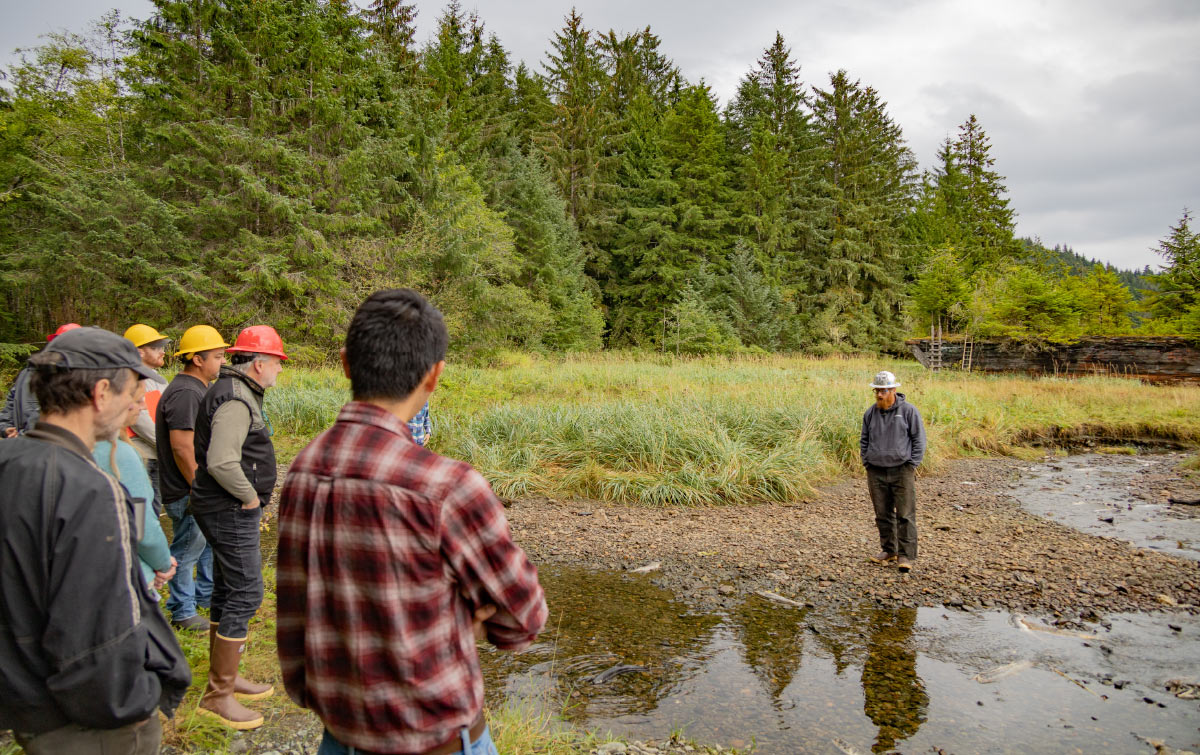


United On Policy

n April 2023, Tesla Cox, Katie Riley, and Marina Anderson traveled roughly 3,500 miles from their homes in rural Southeast Alaska to the US capitol with a thank you. Usually, policymakers in Washington, D.C. are overwhelmed with criticism about what they are doing wrong, or what they aren’t doing enough of. While it is rare for federal legislators and agencies to receive in-person praise for a policy that’s already been enacted, these women are not afraid to challenge norms– especially when they aren’t serving the communities they care deeply about. Representing a for-profit Alaska Native corporation, a grassroots conservation organization, and a collective impact network directed by a previous tribal administrator, Cox, Riley, and Anderson work for organizations that were historically at odds. Today, these individuals and organizations represent a growing shift in the Tongass National Forest within the Sustainable Southeast Partnership (SSP) that is moving away from polarization and fighting, toward collaboration and building common ground– including in the policy arena.
SSP is a collective impact network that, for the last decade, helped bridge divides while cultivating understanding, healing, and momentum towards a common vision. SSP, which includes partners of many different ideological, geographical, and disciplinary backgrounds, came together to build programs that mattered to Southeast Alaskan communities, while building trust and healing relationships. A portion of this work includes influencing federal policies that have an outsized impact on this region, considering that 17 million acres is federally managed as the Tongass National Forest. SSP operates on traditional values creating sustainable, healthy futures for all generations through youth programing like the Alaska Youth Stewards (AYS) to supporting regional policies like the Southeast Alaska Sustainability Strategy (SASS), a $25 million United States Department of Agriculture (USDA) investment focusing on community-driven priorities and ground-up solutions. Marina Anderson, a Haida and Tlingit solutions-based strategist from Prince of Wales Island and who once served as the Tribal Administrator for the Organized Village of Kasaan, became the director of SSP in 2023.


Distraught by the polarization she sees as a policy expert at the federal level and inspired by the impacts she’s seen SSP have at the community and regional level, Riley cracked the idea for this advocacy trip. Riley, as well as Cox and Anderson, all acknowledged how important it was for their organizations to show up for our youth and communities and how powerful it would be for the three of them to show up together. “We’re there for our organizations, but really on behalf of the SSP network as a whole and representing the strength of that collaboration” says Cox, who is the Senior Director of Shareholder Development with Sealaska—a regional Alaska Native Corporation.
Cox, Riley and Anderson, prepared with a gift of smoked salmon and herring eggs, walked into Peltola’s office, which was adorned with traditional Yup’ik dance fans. The sharing of traditional foods was a show of respect and care before entering the conversation. They were there to show both Peltola and Murkowski that progress is being made under SASS, and invite them, Dan Sullivan, and their staffers, to experience the youth program’s place-based learning strategy SASS supports for themselves showing them how decision-making over 3000 miles away truly impacts Southeast Alaskans.


Due to the collaborative nature of SSP and SASS, there is no gatekeeping, these communities and youth programs are sharing information, resources, and mentorship. Each accomplishment made by one community inspires another. As Cox says, “None of us can do it alone, but when we all work together, we can use each other’s strengths and fill in gaps for each other.”
In the rooms of Murkowski, Peltola, and Sullivan, the trio opened their hearts to discussing the importance of developing local career pathways, Indigenous co-stewardship, and policies like SASS for ensuring federal actions support regional economies, community resilience, and conserve the natural resources in Southeast Alaska for culture, sustenance, economic use and beyond. Cox said, “I think it was powerful that we were really there to say, ‘thank you for SASS,’ and ‘this is working and here’s how, and let’s build on that.’ And we used some of that funding to develop projects, and then shared that back with them.” They expressed gratitude and shared the results of SASS in a way that aligns with the traditional values of Southeast Alaska: respect of all things and sharing– values that those in AYS are learning. By investing in SASS and following each community’s lead, policy makers are funding a healthier future for generations of Southeast Alaskans in our people, lands, and waters.
The Alaska Youth Stewards

AYS is founded on the backs of the SSP supported by a variety of partners from the USFS to Tlingit & Haida to Spruce Root, a community economic development institution in Southeast Alaska. It is this partnership that allows the youth to explore such a wide variety of career paths and establish a network of support. In the process of supporting AYS, SSP partners are supporting values-based community needs and initiatives led by these youth crews that will create generational impacts.

Back in the Tongass
In planning the DC trip, the trio acknowledged how youth development and advocacy in many ways are the same. Months after the DC trip in summer, policymakers arrived in Prince of Wales Island. With the goal to build power in relationships through shared experiences, they came to see how AYS are coring and monitoring cedar trees that are important for cultural uses such as totem poles and dugout canoes, so that they can understand why a long-term conservation plan is needed to create generational stability and opportunity. They learned how policy shapes and is shaped by community wants and needs, generationally, through the lasting impressions these experiences create and as communities learn and grow.
In Southeast Alaska, this community-led and driven initiative is key to a healthier future for us all, and as Anderson says “We’re only as healthy as the rest of our regions and communities. If our region is healthy, then we’re able to expand and assist other regions in the state and along the coast and become a healthier part of the world. By engaging in healing from the conflict that our own region has experienced, we’ll actually be able to help heal other parts in the future.” Ultimately, the SSP and SASS are a model for moving forward and creating generational impacts in our society through the power of collaboration, investing in community priorities, and healing. This is the trifecta of building long-lasting solutions because they invest in the people who know these lands and waters best and produce a reciprocal transformation across divides in partnership.
If you are inspired by this article, please call your politicians and tell them what you and your communities need, what is working for them, and what politicians should be representing for us all.